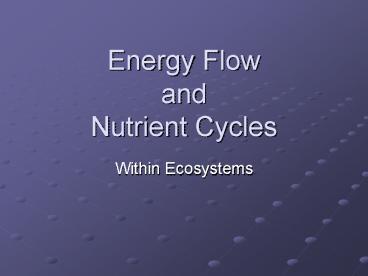Energy Flow and Nutrient Cycles PowerPoint PPT Presentation
1 / 21
Title: Energy Flow and Nutrient Cycles
1
Energy FlowandNutrient Cycles
- Within Ecosystems
2
How did it all get started?
- The concept of ecology was first developed in the
19th century by Ernst Haeckel. - The environment consists of two parts
- 1. biotic (living) environment
- ie. organisms
- 2. abiotic (non-living) environment
- - considered to the living space
- - ie. temperature, soil, wind,
- precipitation, land masses, water
3
What is ECOLOGY?
- the study of the interactions among organisms and
between organisms and their abiotic environments
4
(No Transcript)
5
Energy Flow in An Ecosystem
- All organisms require energy (ATP) and nutrients
in order to carry out essential life activities
such as growth, respiration, and reproduction. - In nearly every ecosystem on Earth radiant energy
provides the energy that powers life. - CO2 H2O chlorophyll yields C6H12O6 H2O
O2 - This energy requirement begins at a cellular
level (ie. cellular respiration). - C6H12O6 O2 yields ATP
- Nutrients (ie. carbon, nitrogen, phosphorous,
water) enter the ecosystem from the abiotic
environment (ie. atmosphere, earth, sea, etc.).
6
Solar Energy...essential, limitless source of
energy!!
- Plants (photoautotroph) convert radiant energy
into chemical energy (glucose)... - THAT energy is then grazed upon and transferred
to herbivores... - THAT energy is then consumed by and transferred
to carnivorous scavengers... - THAT energy is then decomposed by and
transferred to bacteria that break down the
remains of the organism to obtain the last bits
of energy available.
7
Energy Loss...
- As energy flows from plants and then finally to
decomposers, each organism along the way releases
part of the energy they capture as heat to the
atmosphere. - So as the chemical energy moves through the food
chain, it is slowly diminished. - However, energy is re-infused back in the system
by the Sun...again and again.
8
Measuring Primary Productivity
- The amount of life (biomass) an ecosystem can
support is determined by the amount of chemical
energy generated by autotrophs (phototrophs,
chemotrophs) producers. - photoautotroph uses light to make energy (ie.
plants) - chemoautotroph uses chemicals w/in the
environment to make - energy (ie.
bacteria) - net primary productivity
- total E that producers make available to
other - members of the community
- Overall the primary producers in all the
Earths ecosystems use solar energy and nutrients
to - produce an impressive 170 billion tons of
organic - material per year.
9
Primary Productivity (continued)
- - influenced by environmental variables
- (temperature, available sunlight, water,
nutrients) - ie. tundra
- limited by temp range availability of
sunlight - ie. desert
- limited by water nutrients
- ie. temperate wetlands AND tropical rainforest
- radiant energy nutrients are abundant
- (productivity is HIGH)
10
Trophic Levels
- Ecologists categorize living things according to
their role in the flow of energy through an
ecosystem (beginning with producers and through
several levels of consumers) each category
forms a trophic level - first trophic level grasses, giant redwoods
- second trophic level
- caterpillars, grasshoppers, elk (primary
consumers) - herbivores
- third trophic level
- flesh-eating spiders, birds, lions (secondary
consumers) - carnivores who eat herbivores
- fourth trophic level
- bears, eagles, humans (tertiary consumers)
- carnivores who eat other carnivores
11
Food Web
12
Decomposers and Detritivores
- Liberate nutrients for reuse (convert larger
polymers into monomers, molecules and elements). - Small and some are microscopic (live on molted
exoskeletons, fallen leaves, wastes, and dead
bodies). - Include worms,
- insects, and
- aviary vultures.
13
Decomposers (continued)
- In some ecosystems, more energy passes through
the detritus feeders and decomposers than through
the all the consumers combined. - If the detritus feeders and decomposers were to
disappear suddenly, communities would gradually
be smothered by accumulated wastes and dead
bodies. - ALSO, molecules such as carbon dioxide, water,
nitrogen, and phosphorus wouldnt be available
for sustained plant life. - AS A RESULT energy would cease to enter the
community and the higher trophic levels dependent
on the energy captured by plants would disappear
as well.
14
Energy Flow Through Trophic Levels
15
The 10 Law
- The energy transfer between trophic levels in
most ecosystems is roughly 10 efficient. - SO...the energy stored in primary consumers
(herbivores) is only about 10 of the energy
stored in producers...the energy in secondary
consumers possess roughly 10 of the energy
stored in primary consumers... - The most abundant organisms are going to be those
that are lower on the food chain
(producers)...while those that are higher on the
food chain are much less abundant (tertiary
consumers). - SO...the lower the trophic level utilized, the
more food energy available to human populations
(far more people can be fed on grain than on
meat).
16
Nutrients Essential to Life
- Unlike solar energy, the nutrients essential to
life are limited. - The Earth only has so much carbon, phosphorus, or
nitrogen available for living organisms. - If biological processes such as cellular
respiration didnt return most of this captured
carbon back to the atmosphere, life as we know it
on Earth would rapidly end. - So in order for life on Earth to continue,
nutrients must be constantly recycled by the
Earths ecosystems. - ie. water cycle, sulfur cycle, carbon cycle,
nitrogen cycle, - phosphorus cycle
17
The WATER CYCLE
18
The NITROGEN CYCLE
19
The CARBON CYCLE
20
The PHOSPHORUS CYCLE
21
The SULFUR CYCLE

